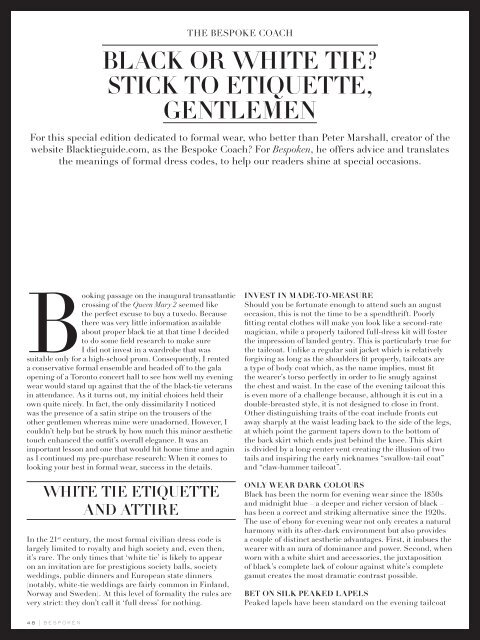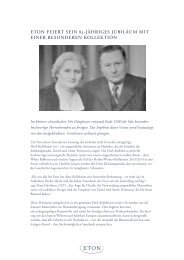Formal wear origins
Formal wear origins
Formal wear origins
You also want an ePaper? Increase the reach of your titles
YUMPU automatically turns print PDFs into web optimized ePapers that Google loves.
Booking passage on the inaugural transatlantic<br />
crossing of the Queen Mary 2 seemed like<br />
the perfect excuse to buy a tuxedo. Because<br />
there was very little information available<br />
about proper black tie at that time I decided<br />
to do some field research to make sure<br />
I did not invest in a wardrobe that was<br />
suitable only for a high-school prom. Consequently, I rented<br />
a conservative formal ensemble and headed off to the gala<br />
opening of a Toronto concert hall to see how well my evening<br />
<strong>wear</strong> would stand up against that the of the black-tie veterans<br />
in attendance. As it turns out, my initial choices held their<br />
own quite nicely. In fact, the only dissimilarity I noticed<br />
was the presence of a satin stripe on the trousers of the<br />
other gentlemen whereas mine were unadorned. However, I<br />
couldn’t help but be struck by how much this minor aesthetic<br />
touch enhanced the outfit’s overall elegance. It was an<br />
important lesson and one that would hit home time and again<br />
as I continued my pre-purchase research: When it comes to<br />
looking your best in formal <strong>wear</strong>, success in the details.<br />
THE BESPOKE COACH<br />
BLACK OR WHITE TIE?<br />
STICK TO ETIQUETTE,<br />
GENTLEMEN<br />
For this special edition dedicated to formal <strong>wear</strong>, who better than Peter Marshall, creator of the<br />
website Blacktieguide.com, as the Bespoke Coach? For Bespoken, he offers advice and translates<br />
the meanings of formal dress codes, to help our readers shine at special occasions.<br />
WHITE TIE ETIQUETTE<br />
AND ATTIRE<br />
In the 21 st century, the most formal civilian dress code is<br />
largely limited to royalty and high society and, even then,<br />
it’s rare. The only times that ‘white tie’ is likely to appear<br />
on an invitation are for prestigious society balls, society<br />
weddings, public dinners and European state dinners<br />
(notably, white-tie weddings are fairly common in Finland,<br />
Norway and Sweden). At this level of formality the rules are<br />
very strict: they don’t call it ‘full dress’ for nothing.<br />
INVEST IN MADE-TO-MEASURE<br />
Should you be fortunate enough to attend such an august<br />
occasion, this is not the time to be a spendthrift. Poorly<br />
fitting rental clothes will make you look like a second-rate<br />
magician, while a properly tailored full-dress kit will foster<br />
the impression of landed gentry. This is particularly true for<br />
the tailcoat. Unlike a regular suit jacket which is relatively<br />
forgiving as long as the shoulders fit properly, tailcoats are<br />
a type of body coat which, as the name implies, must fit<br />
the <strong>wear</strong>er’s torso perfectly in order to lie snugly against<br />
the chest and waist. In the case of the evening tailcoat this<br />
is even more of a challenge because, although it is cut in a<br />
double-breasted style, it is not designed to close in front.<br />
Other distinguishing traits of the coat include fronts cut<br />
away sharply at the waist leading back to the side of the legs,<br />
at which point the garment tapers down to the bottom of<br />
the back skirt which ends just behind the knee. This skirt<br />
is divided by a long center vent creating the illusion of two<br />
tails and inspiring the early nicknames “swallow-tail coat”<br />
and “claw-hammer tailcoat”.<br />
ONLY WEAR DARK COLOURS<br />
Black has been the norm for evening <strong>wear</strong> since the 1850s<br />
and midnight blue – a deeper and richer version of black –<br />
has been a correct and striking alternative since the 1920s.<br />
The use of ebony for evening <strong>wear</strong> not only creates a natural<br />
harmony with its after-dark environment but also provides<br />
a couple of distinct aesthetic advantages. First, it imbues the<br />
<strong>wear</strong>er with an aura of dominance and power. Second, when<br />
worn with a white shirt and accessories, the juxtaposition<br />
of black’s complete lack of colour against white’s complete<br />
gamut creates the most dramatic contrast possible.<br />
BET ON SILK PEAKED LAPELS<br />
Peaked lapels have been standard on the evening tailcoat<br />
© Scabal<br />
EVENING TAILCOAT<br />
Jacket and trousers from the Mohair collection by Scabal - reference 702386<br />
Waistcoat from the Festival collection by Scabal - reference 851762<br />
since the turn of the 20th century. Not only are they the<br />
most formal style of suit lapel but their sweeping upward<br />
diagonal lines also create the impression of a powerful<br />
V-shaped torso. They are faced in silk that can be in the<br />
form of smooth satin or ribbed grosgrain. Although the<br />
former is much more common in North America, its shiny,<br />
somewhat theatrical finish is not as popular in Britain,<br />
where the understated look of grosgrain is often preferred.<br />
MATCH YOUR TROUSERS WITH YOUR LAPEL FACING<br />
Trousers match the coat fabric and feature two narrow<br />
stripes or one wide stripe of silk along the outseams, either<br />
braided or in the same material used for the lapel facing.<br />
These stripes serve to cover the trouser’s working seams and<br />
lengthen the perceived leg line in a manner reminiscent of<br />
military dress uniforms (and you know what they say about<br />
a man in a uniform). Full-dress trousers must be worn with<br />
suspenders as it is crucial that the waistband maintains its<br />
position relative to the waistcoat. <strong>Formal</strong> trousers are never<br />
worn with cuffs (turn-ups in British English).<br />
Never underestimate the role of full-dress shirt<br />
Next to the tailcoat, the full-dress shirt is arguably the<br />
most important component in creating white tie’s regal<br />
bearing. The classic full-dress shirt commands a military-<br />
‘POORLY FITTING RENTAL<br />
CLOTHES WILL MAKE YOU<br />
LOOK LIKE A SECOND-RATE<br />
MAGICIAN.’<br />
like formality with a stiff bosom made from plain linen,<br />
plain cotton or cotton piqué (marcella in the UK). This bibshaped<br />
layer of fabric is heavily starched to give <strong>wear</strong>ers the<br />
appearance of a firm, flat torso, regardless of their actual<br />
physiques. Traditionally the shirt is tunic style and takes a<br />
detachable wing collar. Whether attached or not, the collar<br />
should be taller than regular shirt collars and should stand<br />
stiffly so as to best frame the <strong>wear</strong>er’s face. Sleeve cuffs are<br />
barrel style (single cuffs in British English) that fasten with<br />
cufflinks traditionally made of mother-of-pearl to match the<br />
shirt studs.<br />
MAKE IT YOURS<br />
The full-dress waistcoat serves to conceal the bottom of<br />
the shirt’s bosom and the waistband of the trousers. It is<br />
constructed of white piqué and can be single- or doublebreasted<br />
but is always cut very low to best reveal the shirt<br />
bosom. Its length is a critical consideration as it must be long<br />
enough to cover the trouser waistband yet not so long as to<br />
extend below the coat fronts. Within these parameters there<br />
is room for extensive variation in shape of the waistcoat’s<br />
revers (lapels) and its bottom edge, making it the sole garment<br />
than may be used to add a personal touch to the otherwise<br />
rigid uniform.<br />
FORGET TIE, THINK BOW TIE<br />
The white full-dress bow tie is made from cotton piqué,<br />
the material of choice since the 1930s. And if pre-tied<br />
neck<strong>wear</strong> is considered unrefined in a relatively informal<br />
office environment then it can only be viewed as downright<br />
gauche in the context of an ultra-formal social or diplomatic<br />
function. <strong>Formal</strong> bow ties are meant to be worn outside the<br />
wings of the collar, not tucked behind them.<br />
WEAR FORMAL SLIPPERS<br />
Black formal pumps (men’s court shoes in British English)<br />
have a pedigree stretching back to the royal courts and grand<br />
ballrooms of Europe. They feature a grosgrain bow on the<br />
vamp that is either pinched or lies completely flat. Lace-up<br />
shoes are equally correct provided they have the same slipperlike<br />
silhouette and minimal decoration. Either shoe is most<br />
traditional in patent leather although calfskin is acceptable<br />
provided it is highly polished. For similar reasons as the<br />
pump, the aristocratic pedigree and elegant sheen of silk hose<br />
make them preferable to other types of dress socks.<br />
48 I BESPOKEN BESPOKEN I 49



